During Texas Rising Houston’s Criminal Justice Summit, students and leaders from across Houston’s college campuses came together to ask: What would it take to build a justice system that actually serves people?
I don’t believe in putting children in prison. They need mentors, stable housing, job training, and access to mental health care. These are resources that build them up instead of breaking them down. There are plenty of better ways to help young people grow into healthy, thriving adults who can contribute to their communities rather than being trapped in a system built on punishment and survival.”
Gracie Israel, Texas Rising North Houston Senior Regional Program Coordinator
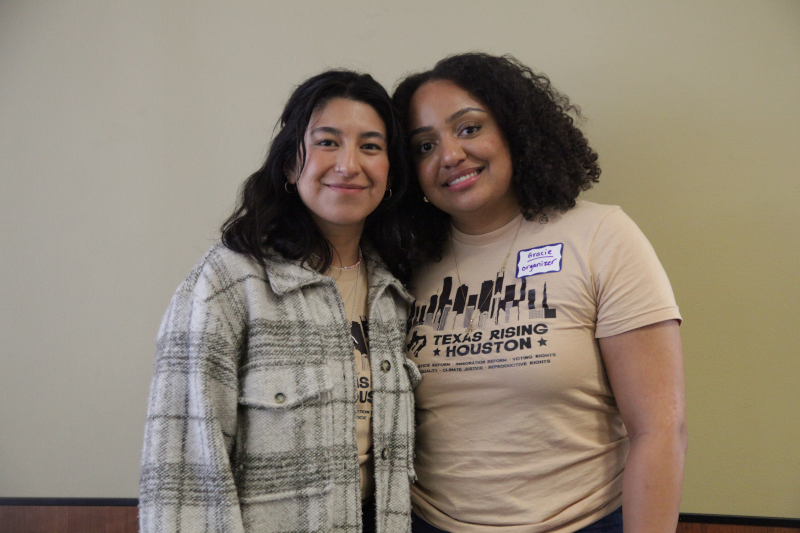
Houstonians are awake and we are watching. We will not stand by the sidelines as politicians and our elected officials force more jails and policing on our communities.”
Jasmine Tellez, Texas Rising South Houston Senior Regional Program Coordinator
The Criminal Justice Summit opened with grounding intentions: to create a safe space for conversation, to raise awareness of how the criminal legal system operates, to build collective power across campuses and communities, and to inspire bold, informed action. It brought together students and leaders from across Houston’s college campuses, some of whom are directly impacted by the system and others just beginning to understand its scope and impact.
Naming the Issue: A System Built on Oppression
During the Criminal Justice Summit, we came together to ask: What would it take to build a justice system that actually serves people? To even begin to scratch the surface of the answer, we had to start with the truth. The penal system wasn’t built to protect us. It was built to control us, break us down, and keep us in our place.
One of the most sobering things discussed was the true origin of policing in America. It began not with protecting neighborhoods or catching “criminals,” but with slave patrol groups organized to chase down enslaved Black Americans. These patrols were violent, dehumanizing, and rooted in white supremacy; characteristics that remain embedded in today’s policing structures. Over time, they evolved into modern-day police departments. The evolution of the modern police state—from its inception in racialized control to its current form as a force of mass surveillance, incarceration, and poverty criminalization—makes clear that the system does exactly what it was built to do. While the uniforms and titles may have changed, the purpose has often remained the same: control, especially control over Black, brown, and poor people. America criminalizes poverty and punishes vulnerabilities.
This history isn’t just academic. It’s personal. When you live in a neighborhood where police feel more like surveillance than safety, when schools have cops but no counselors, or when people are incarcerated for actions others get treatment for, it’s not a coincidence. It is by design.
Reform or Transform? The Urgency of Systemic Change
David Johnson, the Executive Director of Building Promise USA, opened the Criminal Justice Summit with a deep historical focus, challenging participants to understand that our current legal and policing systems are not broken – they were built this way. In his session, Reform or Transform? The Urgency for Systemic Change, Johnson invited us to look past the feel-good buzzwords of “reform” and confront the brutal reality of a criminal legal system designed to punish, profit, and preserve power. From the opening moments, he made it clear: minor policy changes aren’t enough. What we need is radical transformation led by communities, rooted in justice, and unapologetically abolitionist.
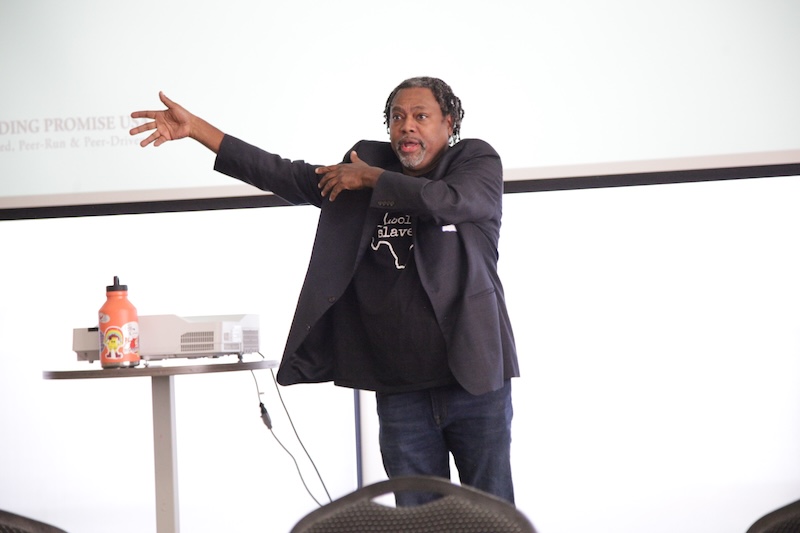
Some folks talk about reform; about making things more “fair.” And yes, changes like bail reform and sentencing reform matter. But Johnson challenged us to think bigger. What if the system itself is the problem? What if we stopped asking how to make prison more humane and started asking why we keep putting people in cages in the first place? Can reform even happen in a system that was designed for failure, or do we need to transform it instead?
Let’s be real: Prison doesn’t make us safe. It just makes people disappear. But the problems that caused the harm, such as poverty, trauma, addiction, and racism, don’t just disappear. They grow, they spread, and they come back.
When Johnson started unpacking the War on Drugs, the room got heavy. He laid out how drug policies, framed as tools to reduce crime, were really weapons of social control. He traced their roots directly back to Nixon-era strategies that criminalized Black and brown communities under the guise of public safety. The War on Drugs did exactly what it was designed to do: fill prisons, tear apart families, and drain resources from communities that needed them most. True transformation means divesting from punishment and investing in care: housing, education, mental health support, and community-led safety initiatives.
Prisons, Jails, and the Bottom Line
Christopher Rivera, Outreach Coordinator for the Criminal Legal Program at the Texas Civil Rights Project, exposed the financial engine behind mass incarceration. He explained how governments, corporations, and counties like Harris make millions by keeping people behind bars. The United States spends over $80 billion a year on incarceration, with Texas allocating billions through its Department of Criminal Justice. In Harris County alone, more than $300 million is spent annually on jails, much of it going toward private contracts and jail expansion. These numbers aren’t just statistics; they reflect deliberate choices to invest in punishment over prevention and confinement over care.
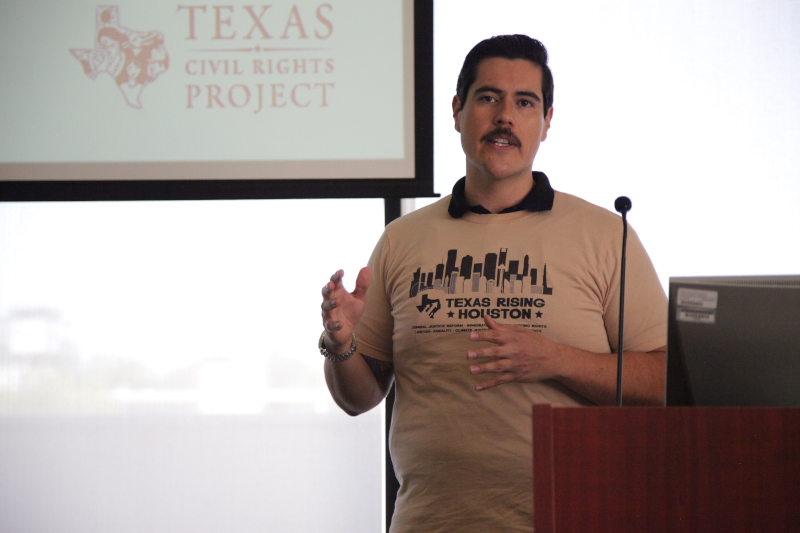
The criminal legal system’s architecture is designed to extract: extract labor, extract wealth, and extract dignity. In Texas, incarcerated people may be forced to work under programs like Texas Correctional Industries, generating tens of millions of dollars while receiving little to no compensation. The legacy of slavery lives on in a system that treats people not as individuals deserving restoration but as resources to be used and discarded.
This system doesn’t just criminalize people; it profits from them. The summit revealed how incarceration sustains an economy rooted in human suffering. The United States incarcerates more people than any other nation, not because it ensures safety, but because it pays. Private prisons, court fees, bail bonds, and prison labor aren’t side effects; they are central to how the system functions. Incarcerated folks work for pennies, or nothing at all, producing goods for corporate profit. It is modern-day slavery in plain sight.
What that means in everyday life is this: A teenager can get locked up for smoking weed while corporations make millions selling it legally in other states. A family scraping by paycheck to paycheck might never see their loved one again. Not because of guilt or innocence, but because they just couldn’t afford bail.
The result is a cycle that devastates entire communities. Juvenile detention increases the likelihood of future adult incarceration by nearly 40 percent. Recidivism remains high not because people are inherently criminal, but because the system offers no meaningful support when people return home. And this devastation is disproportionate. Black Americans, for example, are incarcerated at nearly five times the rate of white Americans.
Restorative Justice and Alternatives to Incarceration
Damion Walker’s session was both personal and visionary. After being incarcerated from age 16 to 33, he founded Cognitive Justice Intl. to bring healing-centered solutions to criminal justice-impacted communities. Restorative justice was offered not just as a practice, but as a philosophy. A way to reimagine safety through healing, accountability, and transformation. Rather than seeing crime as a violation of the state, restorative justice centers the harm done to people and communities, and focuses on how that harm can be repaired. It challenges the assumption that punishment equals accountability, and it emphasizes rehabilitation over retribution.
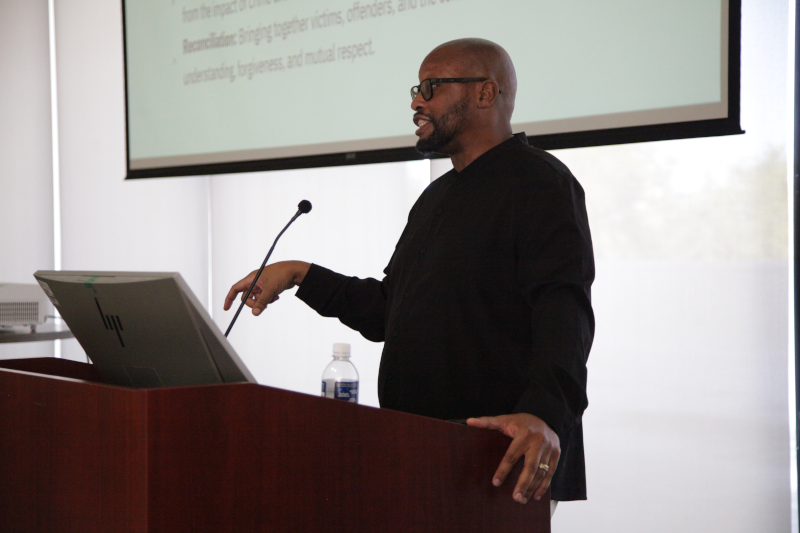
Restorative justice flips the entire script. Instead of focusing on punishing someone, it asks: who was harmed and how can we make things right? It treats harm as something to repair, not something to exploit.
This model is not theoretical. Across the country and the world, real-life examples prove it works. In Oakland, restorative practices in schools drastically reduced suspensions, thus working to prevent the school-to-prison pipeline. In New Zealand and Norway, restorative programs led to significantly lower recidivism rates. These programs prioritize community conferencing and holistic rehabilitation. They equip people with skills, address trauma, and rebuild trust, outcomes that jails and prisons consistently fail to deliver.
Walker explored how labels like “criminal” or “felon” continue to haunt people long after release, limiting their access to housing, jobs, education, and even the right to vote. In the 1990s, Black youth were stigmatized as “super predators,” a label that Walker himself was branded with. This leads to harsher sentences and adult charges for children, and these policies still disproportionately affect marginalized youth today.
These labels are not neutral; they’re tools of social control that perpetuate cycles of poverty and criminalization. To break that cycle, we must stop defining people by their worst moments and instead invest in their potential to grow, contribute, and heal. When we choose to see people not for where they’ve been, but for who they can become, we don’t just change one life; we begin to heal a nation.
Seeking Liberation
The Criminal Justice Summit didn’t just end with theory. It ended with questions meant to activate. Can a system built to punish ever truly be reformed, or must it be replaced altogether? How do we build something new, rooted not in domination, but in care? These aren’t rhetorical questions. They’re invitations and calls to imagine and fight for a future beyond punishment.
Criminal Justice Summit participants left not only with knowledge but with tools. They were invited to join campaigns like “Finish the 5” to shut down juvenile prisons in Texas, to support the Harris County “No New Jails” initiative, and to engage in local advocacy through Texas Rising’s local community advocacy and statewide legislative training. The summit reminded everyone that policy doesn’t change unless people demand it and that young people are uniquely positioned to lead that charge.
Fostering community care through criminal justice transformation isn’t just a slogan. It’s a vision. It’s a commitment to dismantling the systems that harm us and building structures that restore us. It’s the belief that justice should heal, not harm. In Houston, at this summit, that belief was alive, and it’s growing.
Attendees explored the broader picture: who actually benefits from keeping things the way they are? It’s not the working-class families struggling to make rent. It’s not the students burdened with criminal records. It’s not the communities living under constant surveillance. It’s the corporations, politicians, and institutions that thrive on control and fear.
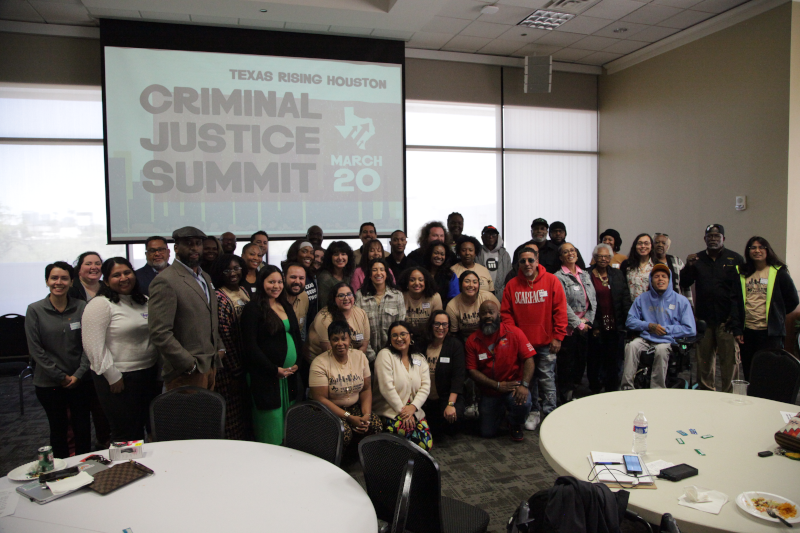
Hope In Action: Building What We’ve Never Had
When we talk about fostering community care, we’re talking about more than ideas. We’re talking about survival. We’re talking about replacing metal bars and mugshots with counseling and compassion. We’re talking about building a world where justice doesn’t mean punishment. It means restoration.
This Criminal Justice Summit wasn’t the end. It was the beginning. A blueprint. A reminder that our communities already hold the answers. We just need to listen to each other, believe in each other, and be brave enough to build something new.
Safety should never come at the cost of dignity. Justice should never be a luxury. Freedom should never depend on your zip code or the intersectionalities you carry. True liberation means creating systems that uplift and protect everyone, leaving no one behind.


